- Quick Read
- Deep Read ( 7 Min. )

Why is Christian Science in our name?
Our name is about honesty. The Monitor is owned by The Christian Science Church, and we’ve always been transparent about that.
The Church publishes the Monitor because it sees good journalism as vital to progress in the world. Since 1908, we’ve aimed “to injure no man, but to bless all mankind,” as our founder, Mary Baker Eddy, put it.
Here, you’ll find award-winning journalism not driven by commercial influences – a news organization that takes seriously its mission to uplift the world by seeking solutions and finding reasons for credible hope.
Explore values journalism About usIn Today’s Issue
Monitor Daily Podcast
- Follow us:
- Apple Podcasts
- Spotify
- RSS Feed
- Download
TODAY’S INTRO
Oscars so what? For real change, Hollywood should focus on hiring.
 Kim Campbell
Kim Campbell
Our stories for you today are on Iran’s self-reflection after a troubling week, China’s emerging role in the Middle East, Quebec’s ban on religious symbols, how parents are talking about politics with their kids, and how offbeat science leads to new thinking. But first, just how upset should people be about this year’s Oscar nominations?
For the second year in a row no women directors were chosen, leaving out Greta Gerwig, for example, who helmed best picture nominee “Little Women.” Only one person of color is in the acting categories: Cynthia Erivo, for her lead role in “Harriet.”
The resulting #OscarsSoMale and #OscarsSoWhite Twitter jabs, the commentary from experts that Tinseltown is stuck in the 1970s, and the creation of spinoff awards come from a public that wants to see a range of perspectives with its popcorn.
Despite the noteworthy omissions, everyone from Gil Robertson, president of the African American Film Critics Association, to Ms. Gerwig says the forward movement of the past few years continues. Last year was a peak one for the ranks of women directing top movies, according to one just-published study. There are also more women nominated this year than in the past. And, in a first, a Korean movie, “Parasite,” and its director, Bong Joon-ho, are best film and director contenders.
Monitor film critic Peter Rainer suggests the solution lies in the pipeline. “The real focus should be on diversity not in the awards stage, but in the initial hiring stage,” he tells me. “It can only benefit the art of film to have as many voices as possible telling and acting in stories.”
As Ms. Gerwig told The New York Times on Monday, “There have been great strides and we’ve got to keep going: keep writing, keep making, keep doing. It’s all there.”
Share this article
Link copied.

Help fund Monitor journalism for $11/ month
Already a subscriber? Login

Monitor journalism changes lives because we open that too-small box that most people think they live in. We believe news can and should expand a sense of identity and possibility beyond narrow conventional expectations.
Our work isn't possible without your support.
Under siege, are Iran’s rulers likely to do more than survive?
What do Iranians want from their leaders – just to do a better job ruling, or fundamental change? In the latest mass protests, one Iranian analyst says, “the voice of the people” is starting to emerge.

The Islamic Republic of Iran is reeling amid a roller coaster of shocking events and fluctuating emotions.
In the aftermath of Maj. Gen. Qassem Soleimani’s assassination, Iranians rallied around the flag, filling the streets in a mass outpouring of grief and anti-American fervor that the country’s leadership held up as a sign of support. Then came the crash of the Ukrainian airliner, with the death of all 176 aboard.
The Islamic Revolutionary Guard Corps’ delayed admission it had shot the plane down in error spurred people into the streets once again, this time with calls for the resignation of Iran’s supreme leader. The protests represent a deepening of anti-regime pressures, now coming from a broader socioeconomic base, as the current array of crises effectively crosses Iran’s social and economic divides.
According to one veteran Iranian analyst in Tehran, university students taking a leading role in the protests have hit on something significant. “The expressions of the students are those of the minds of millions of Iranians,” the analyst says. “Something is boiling, something is starting to emerge as the voice of the people, as a focus on what they want – actually, on what we don’t want.”
Under siege, are Iran’s rulers likely to do more than survive?
In the aftermath of Maj. Gen. Qassem Soleimani’s assassination, Iranians rallied around the flag, filling the streets in a mass outpouring of grief and anti-American fervor that the country’s leadership held up as a sign of continued support.
So, too, were the expressions of national pride in the retaliatory missiles fired at U.S. bases in Iraq.
But then came the crash of the Ukrainian airliner, with the death of all 176 aboard, and the Islamic Revolutionary Guard Corps’ delayed admission it had shot the plane down in error. The moment of flag-waving support passed as quickly as it arrived.
The stunning admission sent outraged Iranians back into the streets. Layered over it all is a deep, abiding dissatisfaction with the government’s stewardship of Iran’s U.S.-sanction-afflicted economy, which just weeks earlier – following an overnight fuel price hike – had spawned its own cycle of mass protest and brutal repression.
Amid the roller coaster of shocking events and fluctuating emotions, the Islamic Republic is reeling. And questions are being raised anew by Iranians about its legitimacy and whether its leaders can cope with the multitude of stresses from within and without, including new U.S. and European pressures.
Inside Iran, the protesters’ slogans are as radical as ever.
“You incompetent leader! Resign, resign!” rang one chant, referring to Iran’s supreme leader, Ayatollah Ali Khamenei. “Our enemy is right here! They are lying, it’s not America!”
The latest protests represent a deepening of anti-regime pressures, now coming from a broader socio-economic base. Some introspection can be expected, analysts say, but the Islamic Republic’s primary instinct – successfully achieved for 40 years – is for survival.
“The level of pressure is unprecedented, because it is multi-layered,” says Adnan Tabatabai, an Iran analyst and head of the Bonn-based Center for Applied Research in Partnership with the Orient.
“What is clear, after the November protests, the killing of Qassem Soleimani, and even the downing of this plane, is that the political self of the Islamic Republic is awakened, so there will be lots of debates,” says Mr. Tabatabai. “I don’t expect any meaningful opening of the political landscape, but people will at least want to see some measures of accountability for decision-making circles.
“When people pour into the streets, the anger that they have – it is obviously accumulated anger, which explodes out of people, and leads to slogans that are maximalist,” says Mr. Tabatabai. “It’s quite understandable, but there is no real way to work with these slogans, because the [Islamic system] will not say, ‘Oh there are segments of our society which are calling for us to leave, so let’s think about leaving.’ That’s not going to happen.”
Protests among poor and rich
Still, analysts say the current array of crises effectively cross Iran’s social and economic divides. Even as protests in November involved the lower classes and targeted President Hassan Rouhani, the new ones – spurred by revelations about a coverup of the plane crash – involve the middle class and aim at the top leadership and IRGC for incompetence and lying.
Regime loyalists and even Guardsmen are disappointed and angry, Iranians say, that officials for days blamed mechanical failure for the crash, and repeatedly ruled out the IRGC mistakenly shooting down the plane. As evidence grew, from video, and photographs, and Western satellite data, the IRGC came clean with emotional apologies. Mr. Rouhani called it a “disastrous mistake.”
Amid the turmoil, three top female anchors on state-run television channels have resigned, with one posting on Instagram: “Forgive me for telling you lies from state TV for 13 years.”
At one university, students were filmed as they avoided stepping on U.S. and Israeli flags painted on the ground. President Donald Trump issued praise for the “wonderful Iranian protesters” – and added to his “maximum pressure” campaign by imposing new sanctions.
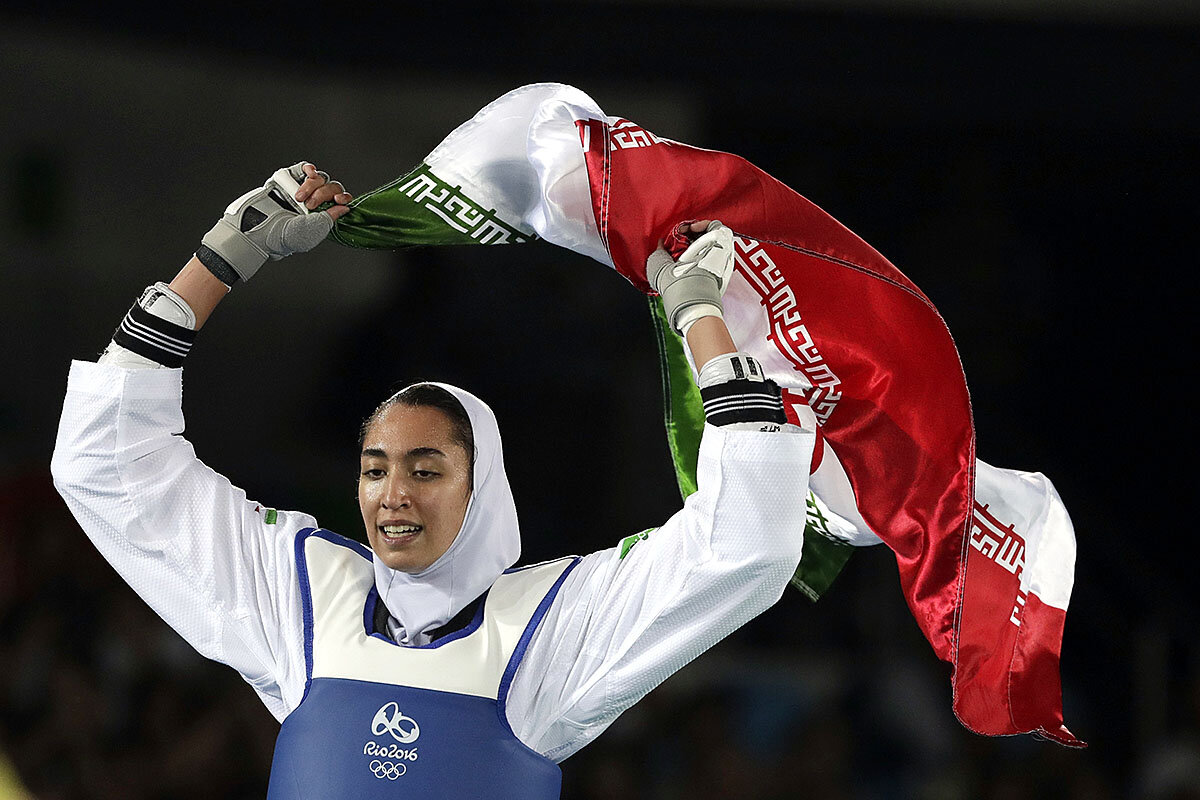
While the risk of immediate war with the United States eased, Britain, France, and Germany added to pressures Tuesday by triggering, for the first time by Europe, a dispute mechanism built into the Iran nuclear deal that, if not resolved, could lead to a snapback of U.N. sanctions. They were reacting to Iran’s announcement last week that it would no longer adhere to enrichment limitations, steps taken because the U.S. unilaterally pulled out of the deal in 2018.
Domestically, criticism of Iran swerved into the sports world, as well. The country’s only female Olympic medalist defected, the third sports personality in three months to leave Iran.
“I am one of the millions of oppressed women in Iran whom they’ve been playing for years. ... I wore whatever they told me and repeated whatever they ordered,” said Kimia Alizadeh, who won a bronze medal in Taekwondo at the 2016 Rio Olympics.
“None of us matter to them, we are just tools,” she wrote in a statement, adding her condolences to the people of Iran, “who are always in mourning.”
Amid the mounting pressures, analysts note the Islamic Republic has faced crises in the past and always found a degree of flexibility to ease pressure inside, or deescalate it with enemies like the U.S. and Israeli outside.
The Iran-Iraq War, for example, ended in 1988 when Iran accepted a cease-fire, ironically after the U.S. Navy shot down an Iranian passenger jet, killing all 290 aboard.
Video has now surfaced of Ayatollah Khamenei, then Iran’s president, reacting to that event. “You shot down our plane ... and now you come out simply saying ‘We made a mistake.’ Seriously? You shut your mouth,” he says, using an offensive term in Persian.
Some protesters now hold banners using those exact words, to criticize their leader’s response this time: “You made a mistake? Just shut your mouth.”
“They don’t learn their lessons”
Another moment of what Mr. Khamenei called “heroic flexibility” came in 2013, when Iran decided to join negotiations that led to the landmark 2015 nuclear deal. Likewise, analysts say the assassination of General Soleimani could be used as a pretext to make changes, such as opening the political space – especially with elections to Parliament due on Feb. 21.
“If they are clever, yes, but they are so obstinate,” says an Iranian analyst in Europe who requested anonymity. But already this week several key reformist lawmakers were barred from running again for office.
“This is the thing with ideologues, [they] keep closing their eyes and their ears and put their head in the sand until it is almost too late, and then do a last-minute turnaround,” the analyst says. “They’ve done this again and again. They don’t learn their lessons, unfortunately.”
As Iran’s leaders measure the need for change, students have led the way in challenging their legitimacy and truthfulness – in part because so many of those on the doomed aircraft were their colleagues, flying to Canada for further studies.
“These days, Iran is full of sadness and mourning. We wash away blood with more blood, we add pain upon pain. ... We experience one crisis after another,” wrote the students of Amir Kabir University in Tehran, where the protests have been noisiest.
“Today we are surrounded by ‘evil’ from every quarter,” the students wrote in a statement, noting that government economic policies and “political suppression” brought people to the “end of their tether,” only to find a new shadow of war overhead.
The statement declares that the U.S. presence in the Middle East “has produced nothing but increasing insecurity and chaos,” and that their duty as citizens is to be against both the “oppressive government” [of Iran] and “imperialist power” [of America].
Voice of the people
According to one veteran Iranian analyst in Tehran, who asked not to be identified further, the students address common concerns.
“The expressions of the students are those of the minds of millions of Iranians,” the analyst says. “Something is boiling, something is starting to emerge as the voice of the people, as a focus on what they want – actually, on what we don’t want.”
One bright spot for Iran’s leaders was the nationwide turnout for General Soleimani’s funeral, which he says was “impressive.”
“I think it showed the power of the Islamic Republic, how this regime survived for the last 40 years,” says the analyst. “Their base of power is because of this. There is a huge social base that goes to elections. ... But the bad economy, the sanctions, has made lots of these people suffer. So where will it show? The people are in trouble, where will it come out?”
The answer to that question will determine how Iran’s leaders can, once again, solve their problems, despite the current erosion of legitimacy.
“Honestly, it doesn’t even matter if they are legitimate or not,” says the Iran analyst in Europe. “The only thing that matters is, can they get Iran out of this mess? That’s all people care about, they don’t care about legitimate or not. Can they fix this mess? That’s it.”
To read the rest of the Monitor’s coverage of the U.S.-Iran clash, please click here.

Patterns
How Iran-US tensions could benefit a new Mideast player: China
Those with a lot to gain from a crisis are not always immediately obvious. But the economic and diplomatic reverberations from the U.S.-Iran clash could play to China's long-term interests.
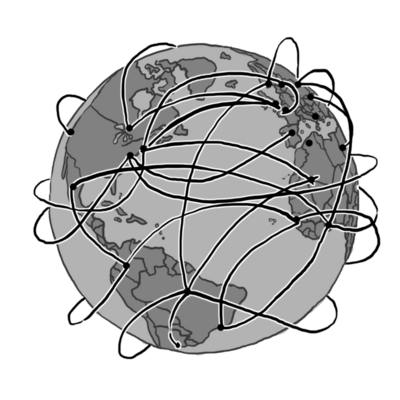
- Quick Read
- Deep Read ( 4 Min. )
The aftermath of the U.S. killing of Iran’s Maj. Gen. Qassem Soleimani has focused attention on familiar Mideast players like Saudi Arabia, Israel, Lebanon, and Russia.
But a less overtly involved power may be most worth watching. When it comes to China’s long-range goals of equaling or surpassing the U.S. in superpower influence, events in the Middle East may be moving in its favor.
Saudi Arabia, America’s closest Gulf ally, has become uneasy over President Donald Trump’s Iran policy. By the time of the Soleimani killing, Gulf Arabs were working to open diplomatic channels with Iran. They’ve also been building relations with China. China, meanwhile, has been increasing purchases of Saudi crude oil, and has established its first overseas naval facility in Djibouti.
Ironically, one main strategic gain for the Chinese could come from Mr. Trump’s decision to pull out of the nuclear deal, and the U.S.-Iranian confrontation that has followed.
Two years ago, a new U.S. National Defense Strategy identified “strategic competition” with China as a top priority. Mr. Trump’s insistence that he’d like to get American troops out of the Middle East may partially reflect that strategy. But regional tensions have forced the U.S. to stall such moves.
How Iran-US tensions could benefit a new Mideast player: China

The main cast in the intensifying conflict in the Middle East is complex enough: the United States and Iran; Saudi Arabia and the other Sunni monarchies across the Gulf; Israel and its Iran-influenced neighbor, Lebanon; and, with increasing clout after its military intervention in Syria, Russia.
But a less overtly involved outside power may be most worth watching: China, with its own growing Middle East economic, diplomatic, and strategic interests. The Chinese are no more immune than anyone else from the immediate effects of the escalation between the U.S. and Iran. Yet they could emerge as principal longer-term beneficiaries.
Even before the U.S. attack that killed Iranian military commander Qassem Soleimani earlier this month, China’s economic strategy in the region had taken a major hit from President Donald Trump’s tightening economic sanctions on the Iranians.
China had been relying on Iran as a major source of oil imports. Iran was also meant to be an important cog in Chinese leader Xi Jinping’s trillion-dollar Belt and Road Initiative: a series of economic, investment, and infrastructure deals with countries across Asia, through the Middle East, and into Europe and Africa.
Yet when it comes to China’s longer-term diplomatic and strategic goal – to equal, and ultimately surpass, the U.S. in superpower influence – events in the Middle East may be moving in its favor.
Uneasy U.S. allies
The Americans’ main Gulf ally, Saudi Arabia, has become increasingly uneasy over Mr. Trump’s Iran policy. The Saudis have long viewed Iran’s expanding political and military influence as the region’s primary security threat, and they initially welcomed the Trump administration’s hard-line approach.
But Mr. Trump’s lack of significant military response to a series of allegedly Iran-instigated attacks in the Gulf – especially a drone strike on Saudi oil facilities last September – left the Saudis and other Gulf Arab states fearful of a wider conflict with Iran in which they’d be left on their own.
One effect was that, by the time of the Soleimani killing, the Gulf Arabs had begun efforts to open diplomatic channels with Iran.
But they’ve also been building their relations with China. While similar outreach to Russia has garnered a lot of media attention, the Chinese have potentially a far greater attraction.
Unlike the Russians, they’re not involved in a shooting war, on the side of an Iranian-backed regime in Syria. The Chinese have begun to dip their toes in militarily, establishing their first overseas naval facility in Djibouti, at the foot of the Red Sea. But China is the equivalent of the new kid in the neighborhood, not only open to, but eager for, relations with all sides.
The Chinese are also a lot wealthier than the Russians. And, unlike the now energy-sufficient U.S., they have a need for oil. China has become the world’s largest oil purchaser. Its imports account for around three-quarters of domestic consumption. With U.S. sanctions greatly reducing Chinese imports from Iran, in fact, Beijing has partly been making up the shortfall by increasing its purchases of Saudi crude.
China: Transactional diplomacy, not taking sides
China’s Middle East approach, at least for now, is purely transactional. The Chinese are ready to provide money, whether for oil purchases or investment and infrastructure projects. In return, they stand to get needed energy supplies, as well as a greater presence in the region. As for the politics, they’re not taking sides, limiting themselves to supporting diplomatic efforts aimed at preventing conflict – notably the bid, however unlikely, to rescue the remnants of the 2015 Iran nuclear deal of which it was a co-signatory.
Ironically, one main strategic gain for the Chinese could come from Mr. Trump’s decision to pull out of the nuclear deal, and the U.S.-Iranian confrontation that has followed.
Two years ago, a new U.S. National Defense Strategy identified “strategic competition” with China as a top priority. Mr. Trump’s insistence that he’d like to get American troops out of the Middle East may in part be a reflection of that new strategy.
But regional tensions have forced the administration to stall moves to draw down its military presence. It has brought back an aircraft carrier and other vessels that had been deployed to the Pacific. Since the Soleimani attack, a further 3,000 American troops have been sent to the area.
How long they’ll stay is impossible to say. So is pretty much anything about the future of the U.S.-Iran showdown, especially with Iran threatening further retaliation, and resurgent street protests against the regime inside Iran.
President Trump does still seem to want to reduce the U.S. military presence, freeing him to focus on getting the necessary trade and economic concessions from China to end their tariff war. His hope appears to be for the European countries in NATO to take over the bulk of the Mideast security burden.
The problem is that, like the Saudis, some NATO partners have begun to question the strength of Washington’s own commitment as an ally. That concern was starkly on view this past weekend, with unprecedented remarks from the defense secretary of America’s closest European partner, the United Kingdom.
Referring to Britain’s own strategic policy review, the first in a decade, Ben Wallace said he was being “kept up at night” by concern over a possible American withdrawal from its international leadership role. “The assumptions of 2010 that we were always going to be part of a U.S. coalition,” he said, “is really just not where we are going to be.”
To read the rest of the Monitor’s coverage of the U.S.-Iran clash, please click here.

In separation of church and state, which institution is being protected?
Does religion need to be protected from the government, or the government from religion? That question is at the heart of debate over Quebec’s decision to ban public workers from displaying religious symbols on the job.

- Quick Read
- Deep Read ( 7 Min. )
When Quebec enacted its controversial Bill 21 last year, it didn’t just ban some civil servants from wearing what it describes as “religious symbols.” The ban on hijabs for Muslim women, turbans for Sikhs, and crosses for Christians also set two opposing views of the separation of church and state against each other.
The gulf traces back to different concepts of what constitutes secularism. In English Canada, like in the United States, secularism is understood as separation of church and state that protects religious minorities. In Quebec, laïcité is more broadly understood as protection of state from religion.
Defenders of Bill 21 trace it back to the province’s struggle against Roman Catholic hegemony in the 1960s. “In Anglo-Saxon countries ... it’s the government intervening,” says Frederic Bastien, a Quebec historian, “whereas in Latin countries ... laïcité serves to protect people from religion.”
But secularism laws are written from a Christian perspective that tends to misinterpret how hard it is to separate self from symbol in some religions, argues Efe Peker of the University of Ottawa. “For a Muslim woman, separating the veil from herself is not the same thing as not wearing a cross for a Christian woman.”
In separation of church and state, which institution is being protected?

Seeba Chaachouch had never pictured her future on the prairies. The third-year law student from Montreal had always envisioned herself practicing in her home province of Quebec.
But that changed after Quebec banned some civil servants from wearing religious symbols on the job – and Ms. Chaachouch, who wears a hijab, saw an ad in her local newspaper from Manitoba’s government wooing Quebecers like herself.
“I’m not going to just take my stuff and leave for Manitoba immediately, but it is something to consider, whether it is Manitoba or Toronto or any other province in Canada,” she says on a recent day on her campus at McGill University, “a place that respects diversity or embraces it, lives with it and is happy about it.”
Placed by Manitoba Premier Brian Pallister in November, the ad was a political statement more than a recruitment effort. It was called “21 reasons why you will feel at home in Manitoba,” a play on the controversial Bill 21 that was adopted in June. The law bans some civil servants in Quebec from wearing what it describes as “religious symbols” – which authorities have said will apply to hijabs for Muslim women, turbans for Sikhs, and crosses for Christians – to keep religion out of the government sphere. It’s the first ban of its kind in North America.
Reason No. 21 is what stood out the most for Ms. Chaachouch: “Manitobans embrace diversity and know that multiculturalism is a strength.”
The ad predictably angered supporters of the bill, who see it as another example of “Anglo” Canada misunderstanding its French-speaking minority. Yet as Quebec follows other European countries to have enacted similar limitations, critics say the law is outdated in increasingly diverse Canada. And while the law wins votes, it could also backfire, they say, in a province where labor is needed and diversity is increasingly a fact of life that depends on peaceful co-existence. Many of Quebec’s religious minorities come from French-speaking immigrant families who were sought to help bolster the French language.
“There is a deep structural contradiction that [Quebec’s leaders] are facing. And none of the measures they are taking is going to address this dilemma,” says Abdie Kazemipur, author of “The Muslim Question in Canada.” “It is out of date with the realities on so many different fronts.”
Protection of religion, or protection from religion?
Quebec’s anxieties over how to integrate minorities into a French-speaking population – one that is itself a minority within North America – have grown since the 2000s, and unease over language has been eclipsed by unease over religion. Various political parties have proposed bans on symbols in the name of public security (in the case of full head coverings) or gender equality.
But none of them was successfully implemented until this summer, after François Legault’s Coalition Avenir Québec (CAQ) won provincial elections and legislated the secularism law, a key platform. Even as it faces court challenge at home, the federal election highlighted its popularity, with the surprise surge of the Bloc Québécois, which supports it.
Outside Quebec, the law clashes with Canada’s notion of itself as a haven of multicultural tolerance, although polling shows support for such bans across Canada – 44% in other provinces, according to a September Leger survey, compared with 64% in Quebec. And it was only tepidly criticized during the federal race – in part from fear that it will raise Quebec’s defenses and rekindle separatism, which has been politically dormant, and for fear of losing votes in the populous province. Yet public commentary and columns continue to vociferously condemn it as racist, while Quebec maintains it has nothing to with discrimination.
The gulf traces back to different concepts of what constitutes secularism. In English Canada, like in the United States, secularism is understood as separation of church and state that protects religious minorities. In Quebec, laïcité, a principle rooted in the French Revolution, is more broadly understood as protection of state from religion. Defenders of Bill 21 trace it back to the province’s Quiet Revolution of the 1960s, which battled against Roman Catholic hegemony. “In Anglo-Saxon countries, people cannot understand laïcité, because for them, it’s the government intervening,” says Frederic Bastien, a Quebec historian, “whereas in Latin countries like France, Italy, Spain, Belgium, laïcité serves to protect people from religion.”
“It is not about race. It’s not about ethnicity,” he adds. “It’s about religion in the public sphere.”
That argument is challenged as a distortion of history, though, as the fight against the Catholic Church’s power never encompassed individual expression of religion, even at work. And in fact while the law may score votes, complaints about authority figures wearing religious symbols are scant. “It’s an answer to a non-question,” says the Rev. Michael Coren, a Toronto-based writer who has criticized the law.
Others have called hypocrisy, underlined recently when Mr. Legault met with the governor of California, Gavin Newsom, and told him blithely that all French Canadians are Catholic.
The primary concern of cultural survival
Secularism laws are also written from a Christian perspective that tends to misinterpret how hard it is to separate self from symbol in some religions, argues Efe Peker, an expert on state-religion relations at the University of Ottawa. “For a Muslim woman, separating the veil from herself is not the same thing as not wearing a cross for a Christian woman,” he says.
Ms. Chaachouch only started wearing a veil in her later teens, but now she wouldn’t conceive of taking it off, which could conflict with her future goals, one of which is to practice criminal law. “I’ve always been very modest in the way I dress. And when I tried it on, it just spoke to me,” she says. “I felt like, this is adding to my modesty, and I love that.”
Her parents are from Lebanon, educated in French, and the type of immigrant the province has sought to help preserve French language and shore up the economy as fertility rates decline. But seeking immigrants, primarily from former French colonies, brought in cultural and religious diversity that turned secularism into a rallying call in the province – something that wasn’t a point of mobilization during the Quiet Revolution.
“The language problem was partially resolved. But if you fast-forward 25 years, then the unintended consequence is that these people turned out to be Muslims, with the religious difference taking over the linguistic difference as the primary concern of cultural survival,” says Dr. Peker.
The multiculturalism has been official policy in Canada since the 1970s. But in Quebec it was seen from the start as an attempt to dilute Francophone influence, rendering French Canadians one of many cultures. Instead they argue for “cultural convergence,” which Guillaume Rousseau, a constitutional law professor at Sherbrooke University who advised the CAQ government on Bill 21, says places French-speaking culture as the official one, while leaving room for others. To that end, Bill 21 is a perfect example, he says.
“That doesn’t mean that all other cultures are forbidden,” Dr. Rousseau says. “This society is more diverse. Great. Now we need to make sure that in some places it’s all about common values.”
But that kind of rhetoric confounds Ms. Chaachouch. “I do really feel excluded as a result of this because I was born here. I was raised here. I speak the language. I went to school here,” she says. “So when people ask me to respect our values, I’m just confused. ... It is a secular state. I respect that. I agree with that, and even if I’m wearing my religious symbol and I walk in to work, it means absolutely nothing for anybody else.”
On Jan. 1, the CAQ government also began “values” tests for some potential immigrants, fulfilling another key campaign pledge.
“Reactive ethnicity”
Defenders of Bill 21 argue that such bans are feminist, and some Muslim women have put their support behind it, happy to remove headscarves. But it’s also generated what University of Toronto sociologist Jeffrey Reitz, who does comparative research on Muslim integration in France and Canada, has called “reactive ethnicity.”
In France, which first outlawed conspicuous religious symbols in public schools in 2004 and full face coverings in public in 2011, some women have felt forced to withdraw from mainstream society, while others have donned headscarves increasingly as a form of protest. “These women were feminists,” says Dr. Reitz. “They were expressing their strong sense of identity with France and the feeling that they should be able to wear whatever they want.”
Quebec’s law might be an outlier in North America, but it’s increasingly familiar in Europe. As many jurisdictions have followed France, from Belgium to Austria to Denmark to Quebec, supporters here say they are on the right side of history.
But Dr. Kazemipur, who is also a professor at the University of Calgary, says that their popularity does not equate to solution. “Authorities say, ‘We want you to put your religion outside the door before you enter the classroom or your workplace,’ but that is not how religions function.”
While Dr. Kazemipur’s research shows that policymakers overemphasize the role of Islam – after 9/11 immigrants once called Pakistani or Lebanese were suddenly labeled Muslim – his newer work shows that religion is finding a bigger place in Canadian society.
“In an environment like that, you cannot just legislate religion out,” he says. “If there are concerns about the lack of solidarity amongst people of different religious backgrounds, then the way to create that solidarity is to create the bonds and the emotional connections and the sense of belonging. With this kind of legislation, you will achieve the opposite.”

In 2020, parents weigh how to talk politics
What role should politics play in the lives of children? With polarizing discussions happening daily in the United States, adults increasingly have to decide when and how much to talk about candidates and issues with young people.
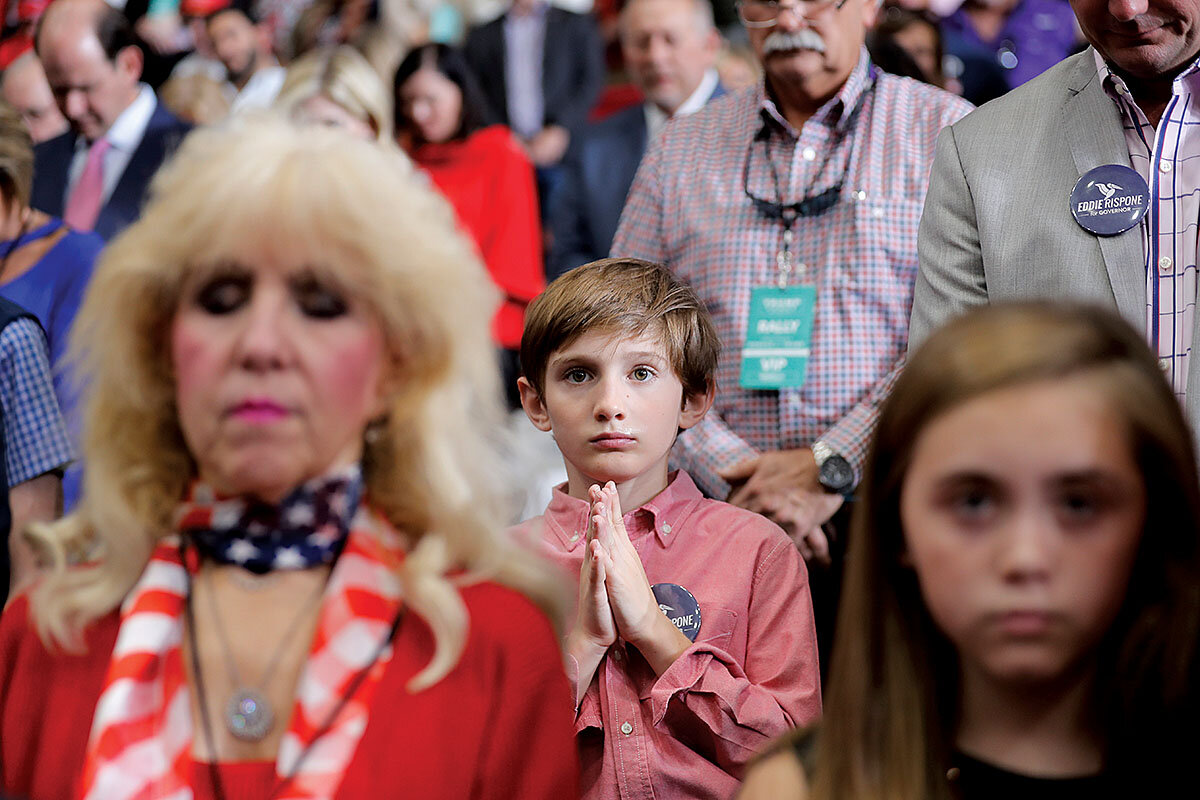
- Quick Read
- Deep Read ( 6 Min. )
-
Chelsea Sheasley Correspondent
Across the United States, parents are grappling with how to shepherd their children through the contentious 2020 election cycle.
Some mothers and fathers involve their offspring in electioneering because they wish to pass along deeply held values. Others want to shield their kids from increasingly rancorous competition between parties. At a time when politics pervades so many areas of life – encroaching even into playground talk – parents are weighing the balance between helping children understand the adult concerns they’re being exposed to and protecting the innocence of childhood.
More discussion, rather than less, may be needed in this media saturated age, experts say. Children pick up tidbits of political knowledge and sometimes draw mistaken conclusions.
Ron Meyer, a Republican from Loudoun County, Virginia, would like to introduce his infant and toddler to politics at a young age, but he’s wary of exposing them to the jading influence of national politics. Instead, he says kids should be taught about local government matters first.
Erin Pahlke, a psychologist at Whitman College in Walla Walla, Washington, understands why some families avoid the topic, but says, “I think right now that kids need some help thinking through the different politicians’ perspectives and the different policies.”
In 2020, parents weigh how to talk politics
Minutes before Elizabeth Warren’s arrival at a recent campaign stop in Manchester, New Hampshire, a political enthusiast sitting in the packed bleachers of a gymnasium recounts a previous time he asked the Democratic presidential candidate a question.
“I asked her about better public school education, because in Detroit, and some other places, public schools aren’t doing well,” the young man explains.
He is 10 years old.
The erudite elementary schooler’s political passions run from the accomplishments of his favorite presidents to sharing opinions about Republicans and supporters of President Donald Trump – the latter bringing a gentle rebuke from his mother.
Sonia Almeida, who is a member of New Hampshire’s Bedford Democrats, appreciates her son’s enthusiasm. But she says she and her husband have struggled with supporting his interests within a political atmosphere that contains “so much negativity.”
“I’m trying to fight for my kid’s future and [get] back to a world of civility,” she says.
Across the nation, parents of all political persuasions are grappling with how to shepherd their children through the contentious 2020 election cycle. Some mothers and fathers involve their offspring in electioneering because they wish to pass along deeply held values. Others want to shield their kids from increasingly rancorous competition between parties. At a time when politics pervades so many areas of life – encroaching even into playground talk – parents are weighing the balance between helping children understand the adult concerns they’re being exposed to and protecting the innocence of childhood.

“We inhabit a highly politicized environment and many parents no longer want to shelter their children. Rather, many treat their children as conversation partners and, in some cases, as bearers of their values,” says Steven Mintz, an expert on the history of the family at the University of Texas at Austin.
Starting them young
Many parents are weaning kids on politics. Niki Campbell’s 2-year-old daughter may still be in diapers, but she already has her own miniature “Bernie 2020” T-shirt. Standing in a parking lot outside a Bernie Sanders rally in Franklin, New Hampshire, Ms. Campbell explains, “I really want to get her involved in politics while she’s young. Kids have a much bigger voice than they’re given credit for.”
Over the past decade, the publishing industry has overseen a spike in political children’s books. Young readers have the option of titles such as “Donald Builds the Wall,” or bestsellers like “A is for Activist.” Indeed, activism is a trait for which Generation Z is known. Issue-driven teens such as Swedish climate change activist Greta Thunberg and high school shooting survivors David Hogg, Emma González, and Kyle Kashuv became household names before they could cast a vote. Schoolchildren regularly participate in gun control, climate change, and “close the camps” marches.
Parents are driving their kids to rallies, helping them make protest signs, and enlisting them for door-to-door campaigning. But some observers see a downside to this type of well-intentioned evangelism.
“My personal worry is less about preserving children’s vaunted innocence than whether we are allowing our children to develop an autonomous identity and the opportunity to grow up at their own pace and to define their own values,” says Mr. Mintz.
Ron Meyer, from Loudoun County, Virginia, would like to introduce his infant and toddler to politics at a young age but he’s wary of exposing them to the jading influence of national politics. He says kids should be taught instead about local government matters first.
“What you should start your children with is actually the government services that impact them the most. ... Who runs your school system? How does that function?” says Mr. Meyer, who was elected to his county’s board of supervisors and has run for state office as a Republican. “I wouldn’t really want to engage my kids in national politics until they’re in high school” and can think more independently.
Filling the void
In our media-saturated age, children are picking up political tidbits from all over and in ways that parents may not be fully aware of. Politics play out in the background of adult lives – whether it’s news radio, podcasts in the car, or TV news while preparing dinner, note Stewart Friedman and Alyssa Westring, authors of the forthcoming book “Parents Who Lead.” The authors advocate becoming more aware of this low-level noise around children – who often jump to their own conclusions.
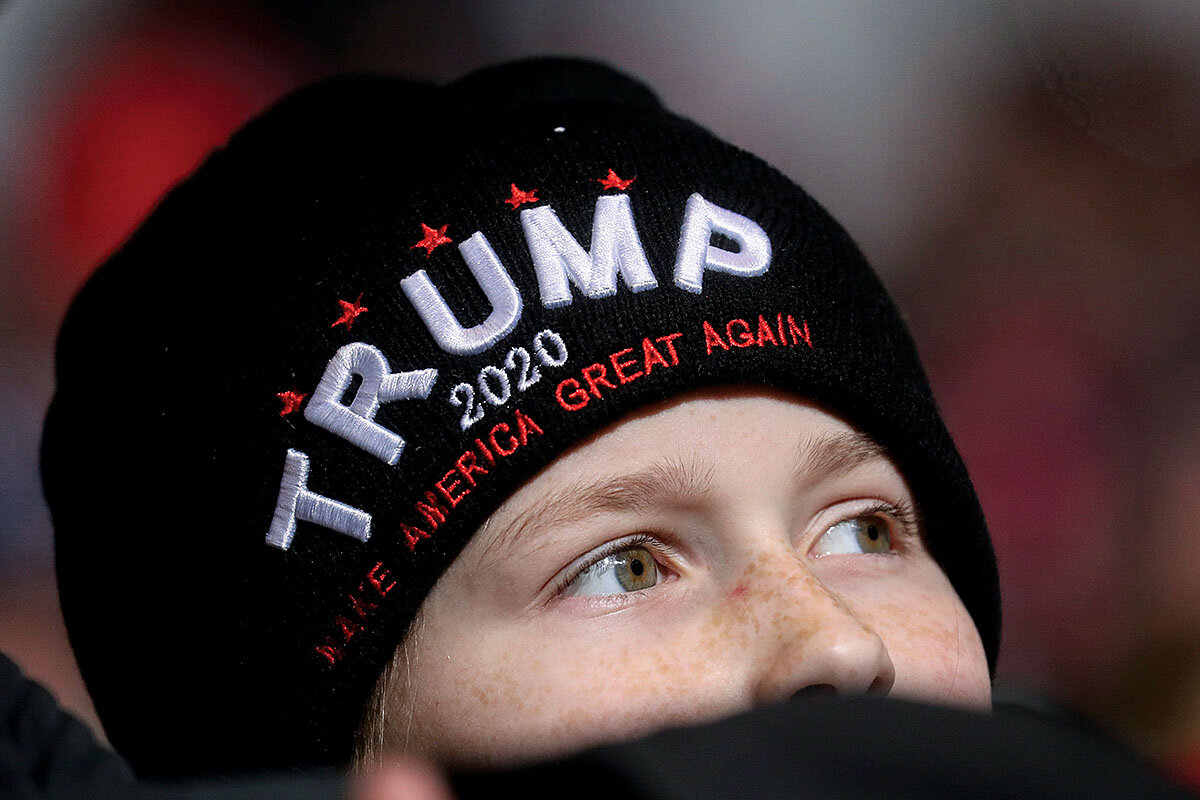
In a recent wide-ranging study of children’s reactions to the 2016 U.S. presidential election, researchers discovered that a quarter of participants between ages 5 and 11 believe it’s against the law for women to be president. Their rationale was based on their observation that no women had been elected to the White House, says Christia Spears Brown, a professor of developmental psychology at the University of Kentucky and a co-author of the 2019 study “Toward a Developmental Science of Politics.”
“We asked them why they thought women had not been president,” she says. “A lot of them said because women wouldn’t want the job, they would want to stay home, they wouldn’t be good leaders. And so what we also see is that in the absence of parents talking to kids about it, kids are coming up with their own explanations that probably parents would be horrified to hear.”
More than 90% of interviewees in the study’s sample from Kansas, Kentucky, Texas, and Washington state expressed a preference for either Mr. Trump or Hillary Clinton. The researchers were struck by children’s negative perceptions of the candidates, compared with previous years. Beyond disagreeing with their policies, they viewed candidates as fundamentally bad people. Children tended to reflect their parents’ politics and the voting patterns of their community, but researchers say only about 20% of the kids in the sample said their parents talked with them about the election a lot
Different approach?
A new political environment may require a different tack than in previous generations.
“When I was a kid, my parents wouldn’t tell me who they voted for,” says Erin Pahlke, psychologist at Whitman College in Walla Walla, Washington, and a co-author of the 2019 study. “They would talk about politics in general. But they were really careful. They did not tell me what they thought of different politicians. And although I can understand where folks are coming from on that, I think right now that kids need some help thinking through the different politicians’ perspectives and the different policies.”
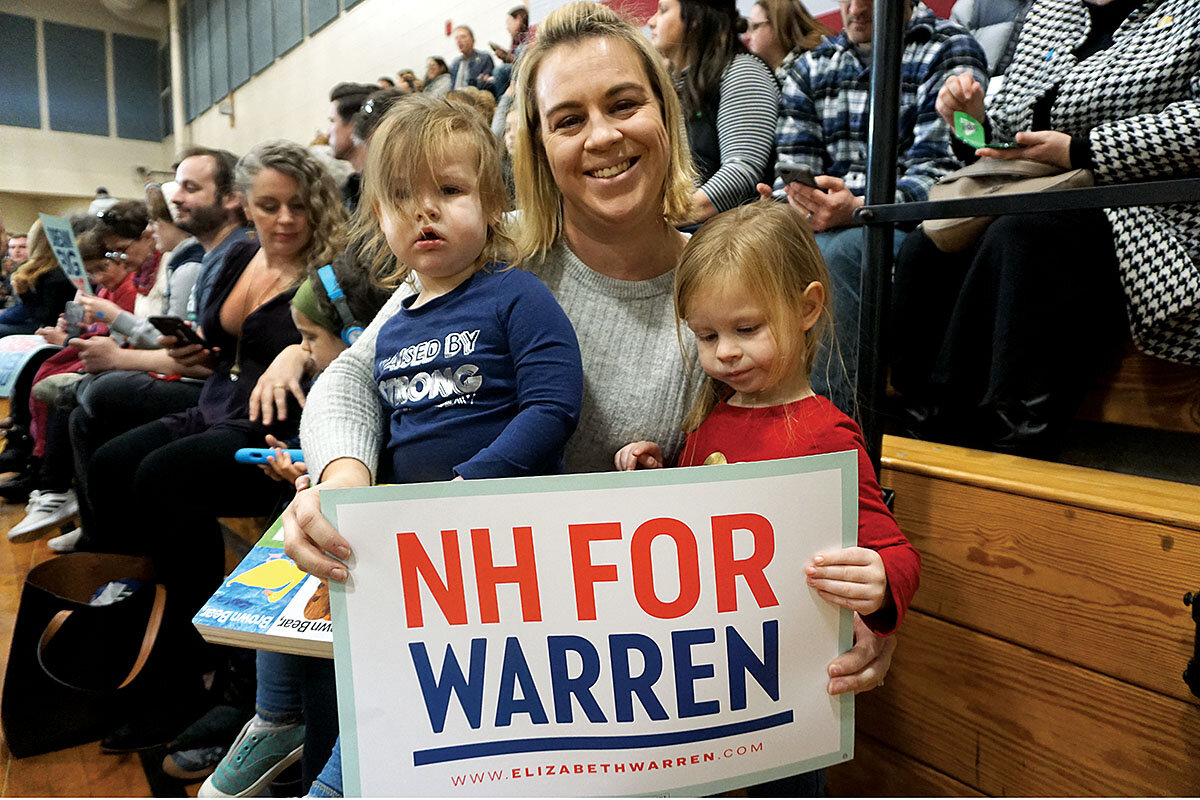
Today’s parents may need to set aside time for non-distracted talk about politics, experts say. “Begin by defining what you value as a family,” write Mr. Friedman and Ms. Westring via email. “Rather than defining yourselves by a particular political party, define yourselves by the values you cherish. Rather than focus on why you don’t like a particular person, focus on why their choices aren’t aligned with your values.”
At the Warren event in Manchester, Erin Columbare hopes the communal gathering offers a positive political experience for her two daughters, who are nearly 2 and 4, sitting next to her on the bleachers.
“I think the real root in politics is wanting to make a change in your community, in your country, in your world,” says Ms. Columbare, before turning to her older daughter and asking, “What did we say we were going to do in the car today? Are we going to change the...?”
“World!” her daughter exclaims.

Beyond the microscope
Why this scientist played AC/DC for ladybugs
Where do ideas come from? For scientists like Brandon Barton, serious inquiry often starts with silly questions. First in an occasional series on the people and stories driving discovery.
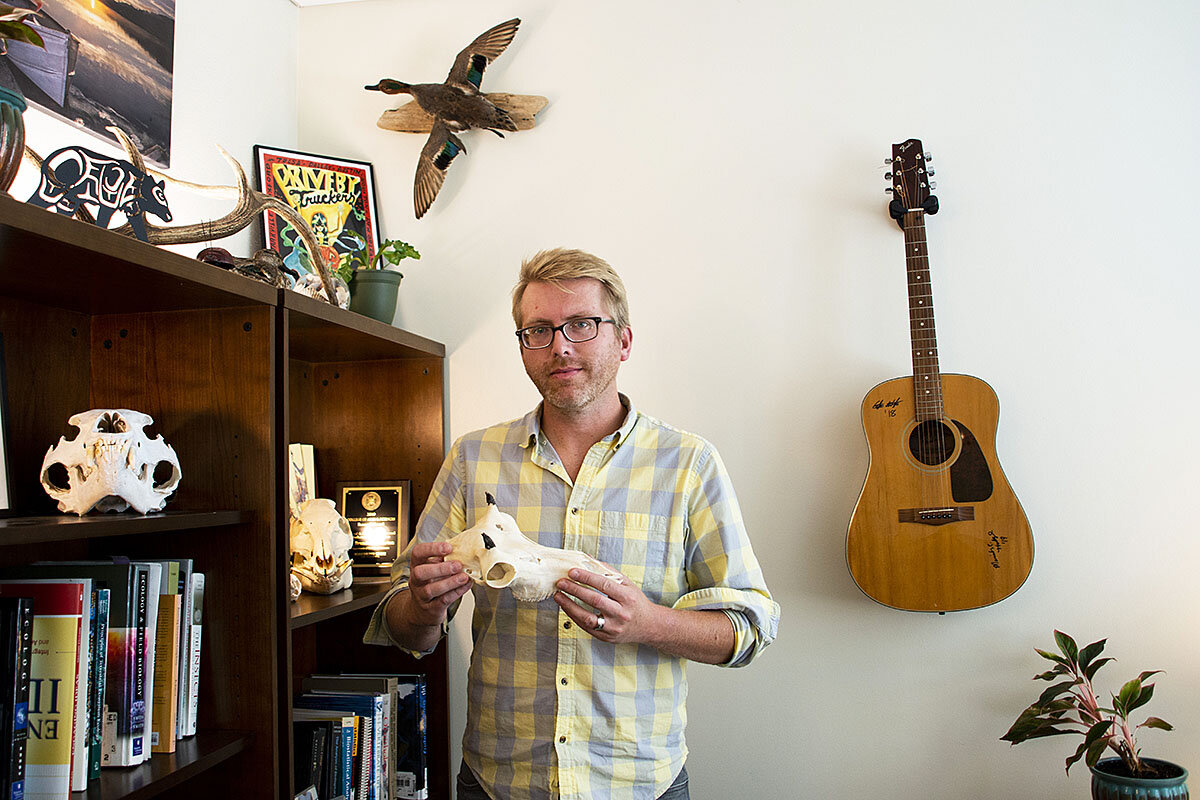
- Quick Read
- Deep Read ( 5 Min. )
Brandon Barton doesn’t quite fit most people’s visions of a scientist. The Mississippi State University ecologist conducts laboratory experiments, of course, but some of his best ideas have come while hiking in the wilderness – or listening to AC/DC.
One of Dr. Barton’s quirkier experiments involved playing AC/DC to ladybugs. That line of inquiry earned his team U.S. Department of Agriculture funding to explore whether sound could be used to keep grasshoppers from eating protein-rich grasses meant for cattle.
Another line of research emerged when he found himself peering intently at wolf poop in the wilderness. That moment of curiosity led to a new understanding about the diet of wolves. Apparently these apex predators sometimes snack on grasshoppers.
His approach marries simple curiosity and seemingly goofy questions with the scientific method in order to explore some of the most relevant environmental questions of the day. And his offbeat research offers a lens into how scientists drive new ways of thinking about the world.
“He does work that has a ‘gee-whiz’ aspect to it,” says Oswald Schmitz, Dr. Barton’s Ph.D. adviser at Yale University. “But it actually has more profound implications.”
Why this scientist played AC/DC for ladybugs
When his mom told him dandelions could grow anywhere, 5-year-old Brandon Barton wasn’t about to take her word for it. So he sprinkled dandelion seeds across the hood of her car. Not surprisingly, they didn’t grow.
Now, all grown up and an ecologist at Mississippi State University, Dr. Barton continues to test out seemingly silly questions about how the biological world works. In the name of science, he has played rock music to insects, watched hog carcasses rot, and dug around in wolf excrement.
But it isn’t without rhyme or reason. Dr. Barton’s research focuses on how one tweak in an ecosystem can trigger a whole cascade of changes. His approach marries simple curiosity and seemingly goofy questions with the scientific method in order to explore some of the most relevant environmental questions of the day. This kind of offbeat research offers a lens into how scientists drive new ways of thinking about the world.
“He does work that has a ‘gee-whiz’ aspect to it,” says Oswald Schmitz, Dr. Barton’s Ph.D. adviser at Yale University. “But it actually has more profound implications.”
For those about to rock
One of Dr. Barton’s quirkier experiments involved playing AC/DC to ladybugs. Inspired by the band’s 1980 hit “Rock and Roll Ain’t Noise Pollution,” he aimed to test how various organisms would respond to rock ’n’ roll.
Ladybugs are part of a food web important to farmers. The little red beetles chow down on aphids, which suck the sap out of plants, often affecting the growth of crops.
So Dr. Barton and a team of graduate students blasted AC/DC, Lynyrd Skynyrd, Guns N’ Roses, and other bands at 95 to 100 decibels into a chamber as ladybugs and aphids went about their business on soybean plants inside. He speculated that if the ladybugs responded poorly to the tunes, more aphids would survive, and the crops wouldn’t grow as well. And that’s exactly what happened.
While rock ’n’ roll isn’t really a concern in farmers’ fields or most natural spaces, tractors are pretty loud (approximately 100 decibels), and humans make a lot of noise with other machinery, too. The novelty of the AC/DC-inspired study garnered a lot of public attention. But the U.S. Department of Agriculture took a more practical interest and agreed to fund another noise pollution study in Dr. Barton’s lab.

Now, Dr. Barton and his students are exploring whether sound could be used to keep grasshoppers from eating protein-rich grasses meant for cattle. They are experimenting with particular frequencies that prompt the insects to opt for high carbohydrate plants instead.
“I’m personally less interested in the application,” Dr. Barton says. What intrigues him is how human sounds, artificial light, and other anthropogenic alterations might have cascading effects throughout an entire ecosystem.
“I think right now people aren’t really paying a lot of serious attention to these kinds of environmental factors, and maybe they should,” says Dr. Schmitz, “and I think Brandon is providing some proof of concept for that.”
Dr. Barton is not alone, though, Dr. Schmitz adds. “He’s part of a vanguard that is showing that we need to take these things more seriously.”
Thinking outside the lab
On the wall of Dr. Barton’s office is a duck with backward feet – a high-school taxidermy project. The first deer he ever shot hangs in his laboratory down the hall. He stuffed and mounted it in his dormitory as an undergraduate student. “People were not happy,” he says, chuckling at the memory.
Growing up in Idaho, Dr. Barton learned to hunt and fly-fish at an early age. “I was the kid that just lived for fishing,” he says, and that shaped his interest in food webs and his keen observational skills – which continue to serve him as an ecologist.
While hiking in the remote wilderness along the Oregon-Idaho border in 2017, Dr. Barton spotted something that most people wouldn’t dare look closely at: wolf poop. It didn’t look like any wolf scat he’d ever seen before. It was filled with grasshopper exoskeletons. The idea that wolves might munch on these insects seemed preposterous – but intrigued Dr. Barton. After further research, he and several colleagues published the findings in September.
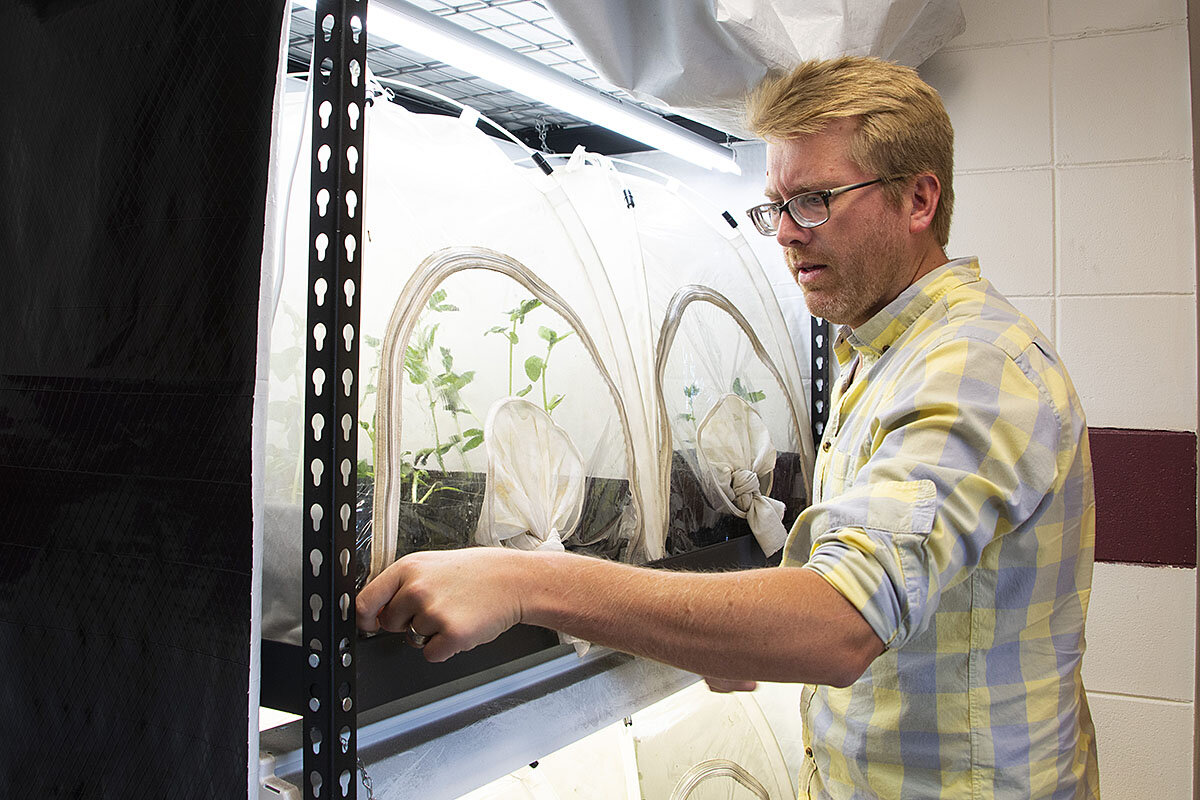
“Dr. Barton is outstandingly creative,” says Bill Ripple, an ecologist at Oregon State University best known for his research on the role of the gray wolf in shaping food webs and landscapes in North America. He is also a co-author on the wolf-grasshopper paper. “He just gets outside and starts noticing.”
Practical jokes
Some experiments have earned Dr. Barton a sort of renown among his co-workers.
“Everybody jokes about Brandon’s dead pigs,” says his department head, Angus Dawe.
Dr. Dawe is referring to the time that Dr. Barton set out to study what happens when a bunch of animals drop dead. To do that, he piled 6,000 pounds of feral hog carcasses in the forest, set up cameras and insect traps, and waited. As the pigs rotted, the researchers tested, measured, and counted everything, from the leaf litter and soil to the maggots, vultures, and other scavengers.
He hoped to shed light on how the landscape and ecosystem respond to mass mortality events – when, say, thousands of antelopes drop dead, hundreds of dead whales wash up on a beach, or millions of animals are killed due to wildfires, as is happening today in Australia.
Dr. Barton does worry that his research might be perceived by some as novelty science rather than relevant research.
“It’s not all just silly things to make people smile like AC/DC and wolf poop and piles of dead animals,” he says. The goal is for the public to benefit in some way from the answer, and for scientists to be able to build upon what he’s done.
But most of all, Dr. Barton and his students have to find it interesting, he says. “We don’t get paid super well. We work too many hours. It’s often thankless. Some people hate what we’ve done. So you can’t be doing this for the glory or the money. It has to be some sort of intrinsic passion to know the answer.”
And that enthusiasm is “infectious,” says Dr. Dawe. “It lets me get excited about the work without it being something I’d ever want to do myself.”
Other headline stories we’re watching
(Get live updates throughout the day.)The Monitor's View
Taiwan’s soft-power sovereignty from China
- Quick Read
- Deep Read ( 2 Min. )
-
By the Monitor's Editorial Board
The island nation of Taiwan just offered an example on how much power these days relies less on physical force than on attractive ideas. It held its seventh direct presidential election Saturday, which alone is a model for China to follow. But its voters also reelected the country’s first woman president, Tsai Ing-wen, by a wide margin.
Yet for all the success of Taiwan’s soft power as a democracy, President Tsai has also built up another attractive quality – one that counters China’s attempts to coerce and isolate a territory it claims as its own. Over the past four years, she has tapped the country’s political and social freedoms to nurture creativity and collaboration in its technology industries. Taiwan is now the fourth most competitive country in “innovation capability.”
The island nation is finding that the protection of its sovereignty increasingly lies in democratic ideals and the freedom of thought that allows for innovation in science and engineering. “We value the lifestyle of democracy,” Ms. Tsai said in her victory speech. In the long run, the power of attraction is greater than the force of arms.
Taiwan’s soft-power sovereignty from China
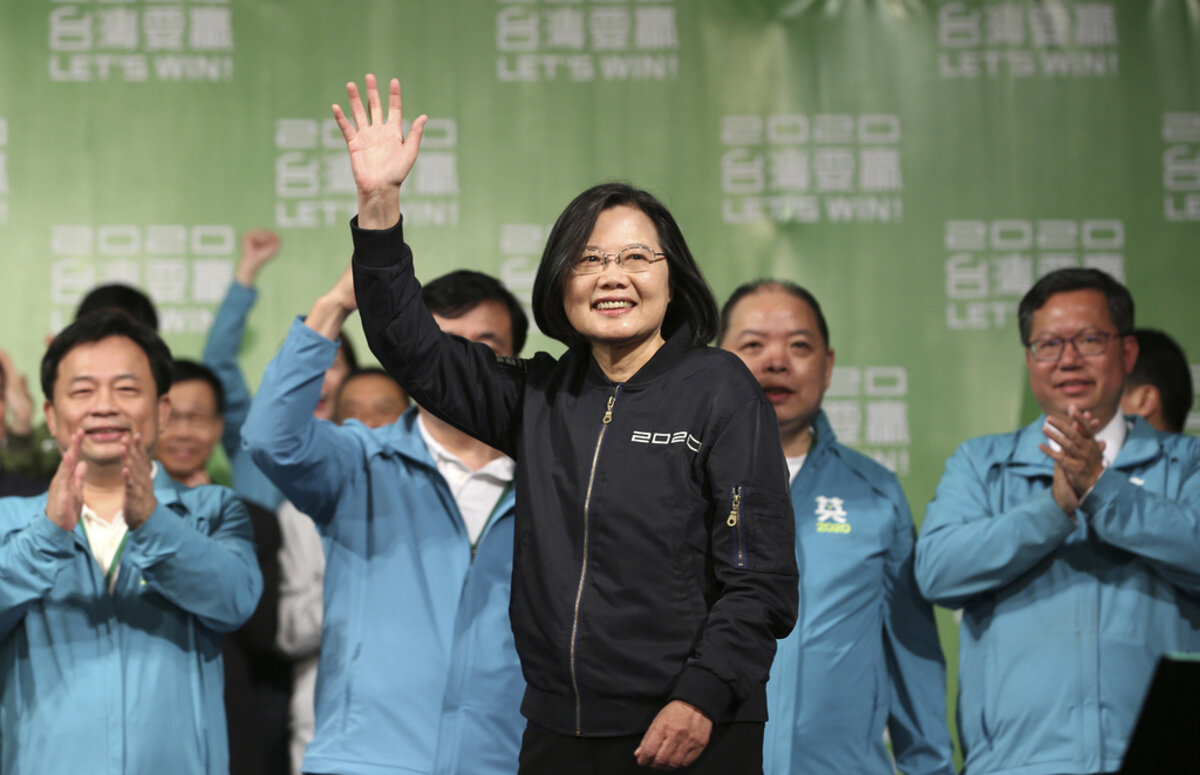
An island nation with 23 million people, Taiwan just offered an example on how much power these days relies less on physical force than on attractive ideas. As the only democracy in the Chinese-speaking world, Taiwan held its seventh direct presidential election Saturday, which alone is a model for China to follow.
But its voters also reelected the country’s first woman president, Tsai Ing-wen, by a wide margin. In addition, her victory was bolstered by young people coming out to support the island’s rule of law after watching Beijing’s crackdown on semi-autonomous Hong Kong over the past year.
Yet for all the success of Taiwan’s soft power as a democracy, President Tsai has also built up another attractive quality – one that counters China’s attempts to coerce and isolate a territory it claims as its own. Over the past four years, she has tapped the country’s political and social freedoms to nurture creativity and collaboration in its technology industries.
Ms. Tsai’s policy efforts have boosted industrial innovation, helping to reduce a dependency on the mainland’s cheap labor and shielding Taiwan from economic coercion by Beijing. She has put a special focus on green technologies, hoping to derive 20% of electricity from renewable sources by 2025, up from the current 5%.
Taiwan is now the fourth most competitive country in “innovation capability,” according to the 2019 Global Competitiveness Report. The quality and quantity of its research and development are close to the top three leaders, Germany, the United States, and Switzerland. Taiwan is also 33rd in macroeconomic stability, a result due in part to its solid foundation as a democracy and a protector of patents.
Taiwan’s unemployment rate is the lowest in two decades. Its economic growth now exceeds that in Singapore and South Korea. And, with the help of a trade war between the U.S. and China, it is luring Taiwanese companies back home from the mainland.
The island nation is finding that the protection of its sovereignty increasingly lies in democratic ideals and the freedom of thought that allows for innovation in science and engineering. “We value the lifestyle of democracy,” Ms. Tsai said in her victory speech. In the long run, the power of attraction is greater than the force of arms.

A Christian Science Perspective
Each weekday, the Monitor includes one clearly labeled religious article offering spiritual insight on contemporary issues, including the news. The publication – in its various forms – is produced for anyone who cares about the progress of the human endeavor around the world and seeks news reported with compassion, intelligence, and an essentially constructive lens. For many, that caring has religious roots. For many, it does not. The Monitor has always embraced both audiences. The Monitor is owned by a church – The First Church of Christ, Scientist, in Boston – whose founder was concerned with both the state of the world and the quality of available news.
Loving our neighbors
- Quick Read
- Read or Listen ( 4 Min. )
-
By Lindsey Biggs
How can we love those around us, especially those who might be a source of frustration to us? For one family, an experience they had with new neighbors reminded them that the key to loving others is seeing and acknowledging the goodness – and godliness – inherent in everyone.
Loving our neighbors
Loving others can sometimes feel like a tough task. There seems to be so much that tries to divide us. How can we find a deeper love for others that enables us to live in harmony and peace despite our differences?
I have found encouragement in this direction and a deeper spiritual perspective in the Bible. Christ Jesus highlighted the two great commandments – to love God and to love our neighbor as ourselves (see Matthew 22:35–40). The first of these commandments can sometimes seem easier than the second one!
But I’m beginning to see that my love for God has to be expressed by my love for my neighbor, no matter who they are. Love has to be big enough to include everyone. As the Bible says: “If we say we love God and don’t love each other, we are liars. We cannot see God. So how can we love God, if we don’t love the people we can see?” (I John 4:20, Contemporary English Version). And Mary Baker Eddy, the discoverer of Christian Science, wrote: “We should measure our love for God by our love for man” (“Miscellaneous Writings 1883-1896,” p. 12).
My husband and I had an experience that taught us a lot about what it means to love your neighbor. New neighbors had moved in above us, and we could hear their every little movement. At first we tried to communicate about the noise level, but it didn’t seem to resonate. My husband and I felt pretty resentful and longed for the peace and harmony we enjoyed before they moved in. After several weeks, however, we had an opportunity for a change in perspective.
My husband was leaving for the day, and as he tried to start the car, he realized that the car battery was dead. Our new neighbors noticed our need and came out to help, even though our previous interactions with them hadn’t been the most harmonious. They helped us try to jump the car, and when that didn’t work, they drove my husband to an auto store to get a new battery. They even helped us install it.
Overall, they spent more than an hour of their time on a Saturday morning helping us out, even with a relative in town visiting them. It was totally unexpected, and we were immensely grateful. When we expressed our profound gratitude, they replied that this is simply what neighbors do.
Well, you can imagine the change of heart we had after that. These neighbors expressed humility, unselfish service, generosity, and compassion during our time of need. Being on the receiving end of these qualities, qualities that have their source in God, transformed our thought, and helped us glimpse what had been true all along – the inherent spirituality and goodness of our neighbors. After all they, like all of us, were made in the image and likeness of God.
This experience has served as a reminder to us that we should always be looking for the good in those around us, because God’s goodness is reflected by everyone. That is all God ever knew about our neighbors, and through the Christly service they expressed, our eyes were opened to see more of their true light.
Even though the noise level hadn’t changed, we had a new spiritual view of our neighbors and our home. When we heard them walking around, we would think of them with love and kindness instead of grumbling over the disruption. Eventually they did get some rugs and furniture, which helped dampen the noise, for which we were grateful.
It was amazing how one unselfish act of service brought about a complete healing and transformation of our home life. Their neighborly love was an example to us!
We may not all have the opportunity to help neighbors fix their car, but we do have the opportunity to treat everyone with love and respect. Living Christ Jesus’ commandments becomes more natural when we start from the standpoint that we are each the blessed, spiritual children of God, filled with amazing capacities to love and do good. Seeing others from this spiritual perspective, despite our differences, supports healing and helps us live harmoniously with each other, without distrust or resentment.
I’m grateful for the opportunities we all have to break down barriers that would keep us from loving one another. As we strive to see everyone around us as a child of God, we will discern our and others’ spiritual nature more clearly and be able to respond in any situation with love. As children of one Spirit, we are each the loved and lovable expressions of God.

A message of love
A real champion

A look ahead
Thanks for joining us. Come back tomorrow and learn about the compromises being made to handle the growing number of wild horses in the West.


